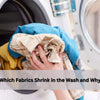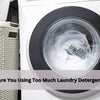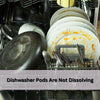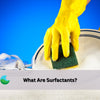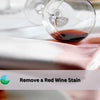Why Blue Tablets Could Be Damaging Your Toilet Tank
- by Brodie Cook

Why Blue Water Isn't a Clean Sign
Sometimes the toilet stops working the way it should. The flush goes soft. The water sits in the bowl. You might notice a blue ring that won’t go away. Or the tank keeps running for no clear reason.
It’s easy to think the toilet is just wearing out or just old. But these small issues can build up fast. One by one, they turn into bigger jobs that take time and money to fix.
A lot of it comes down to the way you clean your toilet. Some products seem like a quick way to clean, but they do more harm than good. What looks like a clean toilet can hide damage that starts in the tank.
The Flush Valve Fails First
Inside every toilet tank is a part called the flush valve. It controls how water flows into the bowl each time you flush. When tablets sit in the tank water, they release chemicals that wear this part down.
The valve can become sticky or brittle. Sometimes it doesn’t close all the way, which means water keeps leaking into the bowl. In other cases, the valve gets blocked by small chunks that break off the tablet.
This is why plumbers often see toilets that keep running or won’t flush at full strength. The problem isn’t always visible, but it starts inside the tank, right where the tablet sits.
Blue Goo Slows Everything Down
If the toilet bowl isn’t clearing with one flush, it might not be a clog. It could be blue goo from a tablet breaking down in the tank. The water thickens and slows everything down.
This gel clings to rubber parts and blocks water flow. It stops the flush from rushing into the bowl like it should. Instead of clearing the bowl, the water swirls and sits. Many think it's a pipe issue, but it often starts in the tank.
When “Fresh” Means Toxic
Blue tablets don’t just work during the flush. They keep breaking down in the tank and releasing chemicals all day. Those fumes build up even when the toilet isn’t being used.
In small bathrooms, this can affect your indoor air. The tank stays closed, but the air doesn’t. Over time, those chemicals spread through the room. Some blue tablets use bleach. Others add strong scents and dye. All of them can be harmful if they sit in the air for too long.
You might not notice right away. But that doesn’t make it safe. What smells fresh can still be harmful, especially in a space you use every day.
Tablet Residue Can Hide Bigger Problems
Blue water can hide rust, lime, and mineral stains. The dye covers early signs of trouble, so you don’t see the damage building up.
Some tablets mix with minerals and turn into a gel. That gel can clog the rim jets, making the flush weak. By the time the colour fades, the parts may already need repair.
These tablets look like they keep things clean, but they make real issues harder to spot.
The Environmental Impact No One Talks About
When a toilet tablet flushes away, it doesn’t just disappear. The chemicals in it, especially chlorine, end up in local water systems. Over time, this can affect the water that flows back into rivers and treatment plants.
Most people don’t think about what happens after the flush. But plumbers have started pointing it out. In places like Northern Utah, even small amounts of these cleaners are causing harm to local ecosystems. Fish and plant life are sensitive to the same chemicals used in toilet tablets.
If you’re already using eco-friendly sprays or low-waste products in other parts of the house, it makes sense to take a second look at what’s going into the toilet too. It’s one small change that can make a big difference.
Hard Water + Tablets = Permanent Blue Rings
If you live in a hard water area, those blue drop-in tablets can leave more than just colour behind. When the chemicals in the tablet mix with minerals in the water, they react. This forms a blue ring where the water sits in the bowl. It might look like mould or limescale, but it’s actually a chemical stain.
These marks can be tough to remove and often stick around for months. Many people try to scrub them off without realising the stain was caused by the tablet itself. If you’re trying to clean it without harsh products, use a mix of white vinegar and baking soda. Let it sit in the bowl, then scrub gently with a soft brush or a pumice stone.
Using a bleach-free toilet cleaner from the start helps avoid these stains. Lucent Globe's Toilet Cleaning Sheets, won’t leave behind dyes or cause chemical reactions with hard water. They clean the bowl without the risk of permanent marks.
Ditch the Blue Tablets for Good
Keep your toilet fresh without harsh bleach or dyes. Lucent Globe Toilet Cleaning Sheets clean deep and protect your tank parts. No blue rings, no fumes.
Shop Toilet Cleaning SheetsAlready Have Blue Goo? Here’s How to Fix It

If your toilet has started flushing slowly or leaving behind water, the problem might be blue goo. It forms when tablets break down and mix with minerals in the tank. Here's how to clean it out before you call a plumber.
Step 1: Turn off the water
Look for the tap near the base of your toilet and turn it off. This will stop more water from entering the tank while you clean.
Step 2: Flush to empty the tank
Hold the flush lever down until most of the water drains out. This gives you space to see and reach the goo inside.
Step 3: Remove the tablet (if still there)
If there’s still a piece left, take it out. Use gloves to avoid direct contact with the chemicals.
Step 4: Scoop out the blue goo
Use a plastic cup or container to gently scoop out any blue sludge at the bottom of the tank. Wear gloves and be careful not to damage any parts.
Step 5: Rinse the tank
Fill a jug or bucket with clean water and pour it into the tank. Swish the water around gently to help loosen leftover residue.
Step 6: Flush a few times
Turn the water back on, let the tank fill, then flush it two or three times. This helps clear out anything left behind.
Step 7: Inspect the flush
Check if the water flow has improved. If it still flushes slowly, the rim jets may need extra attention. Try using vinegar in the tank and bowl to soften buildup naturally.
A Safer Alternative: Lucent Globe Toilet Cleaning Sheets
If you’ve had issues with blue goo, stains, or toilets that won’t flush properly, there’s a better way to keep things clean. Our Toilet Cleaning Sheets are made to do the job without the damage.
Here’s why they’re a smarter choice:
-
No bleach and no harsh dyes
-
Safe for pets and septic systems
-
Don’t damage internal parts or seals
-
No chemical fumes sitting in the air
-
Also great for hard water areas
-
No more blue rings or sticky sludge
-
Compact and easy to store
-
Drop in the bowl, brush and flush
TIP: Also, read how to clean a toilet without any harsh chemicals.

 Dishwashing
Dishwashing Laundry
Laundry Bundles
Bundles Surfaces
Surfaces Toilet
Toilet Handsoap
Handsoap Multi-Purpose
Multi-Purpose Floor
Floor
